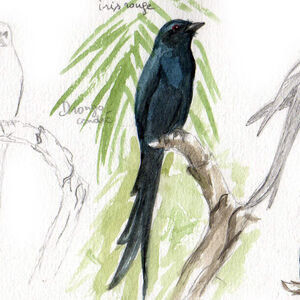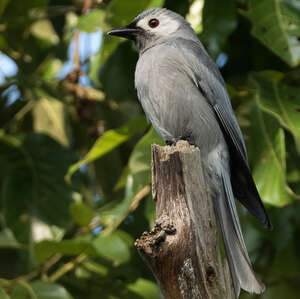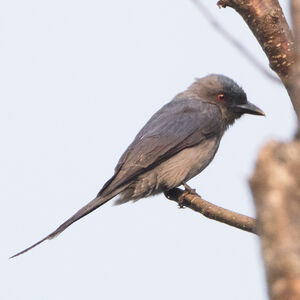Ashy Drongo
Dicrurus leucophaeus - Drongo cendré
Identification
Subspecific information 15 subspecies
- Dicrurus leucophaeus leucophaeus (Java, Bali, Lombok and the sw Philippines)
- Dicrurus leucophaeus longicaudatus (e Afghanistan to c Himalayas)
- Dicrurus leucophaeus hopwoodi (e Himalayas through s China and n Myanmar to ne Indochina)
- Dicrurus leucophaeus nigrescens (s and se Myanmar and the Malay Pen.)
- Dicrurus leucophaeus mouhoti (sw and c Myanmar to c Indochina)
- Dicrurus leucophaeus celaenus (Simeulue I.. off w Sumatra.)
- Dicrurus leucophaeus bondi (c Thailand through s Indochina)
- Dicrurus leucophaeus leucogenis (c, n and e China)
- Dicrurus leucophaeus salangensis (se China)
- Dicrurus leucophaeus innexus (Hainan I.. off se China.)
- Dicrurus leucophaeus periophthalmicus (Sipura and Pagai Is.. off w Sumatra.)
- Dicrurus leucophaeus siberu (Siberut I.. off w Sumatra.)
- Dicrurus leucophaeus batakensis (n Sumatra)
- Dicrurus leucophaeus phaedrus (s Sumatra)
- Dicrurus leucophaeus stigmatops (n Borneo)
Foreign names
- Drongo cendré,
- Drongo cenizo,
- drongo-cinzento,
- Graudrongo,
- szürke drongó,
- Grijze Drongo,
- Drongo cenerino,
- grå drongo,
- Askedrongo,
- drongo popolavý,
- drongo kouřový,
- Askedrongo,
- tuhkadrongo,
- drongo cendrós,
- dziwogon popielaty,
- pelēkais drongo,
- Пепельный дронго,
- Srigunting kelabu,
- ハイイロオウチュウ,
- 灰卷尾,
- นกแซงแซวสีเทา,
- 灰卷尾,
Habitat
Forest : Subtropical/Tropical Moist Lowland, Subtropical/Tropical Mangrove Vegetation Above High Tide Level, Subtropical/Tropical Moist Montane ; Savanna : Dry ; Shrubland : Subtropical/Tropical Dry, Subtropical/Tropical Moist ; Artificial/Terrestrial : Arable Land, Plantations, Rural Gardens, Subtropical/Tropical Heavily Degraded Former Forest
Threats - protection
IUCN conservation status
Extinct
Threatened
Least
concern
concern
Extinc
in the Wild
in the Wild
Near
threatened
threatened
Not
evaluated
evaluated
EX
EW
CR
EN
VU
NT
LC
NE
Sources of information
- Handbook of the birds of India and Pakistan Vol 7, Salim ali et Dillon Ripley
- Vol. 12 - Handbook of the Birds of the World, Josep del Hoyo-Andrew Elliott-David Christie
- ARKive, Christopher Parsons
- Avibase, Lepage Denis
- BirdLife International, BirdLife International
- HBW Alive,
- Wikipedia (English version),
- IOC World Bird List (v15.1), Gill, F and D Donsker (Eds). 2025-12-07.
Other sources of interest
- Accipitriformes
- Aegotheliformes
- Anseriformes
- Apodiformes
- Apterygiformes
- Bucerotiformes
- Caprimulgiformes
- Cariamiformes
- Casuariiformes
- Charadriiformes
- Ciconiiformes
- Coliiformes
- Columbiformes
- Coraciiformes
- Cuculiformes
- Eurypygiformes
- Falconiformes
- Galliformes
- Gaviiformes
- Gruiformes
- Leptosomiformes
- Mesitornithiformes
- Musophagiformes
- Nyctibiiformes
- Opisthocomiformes
- Otidiformes
- Passeriformes
- Pelecaniformes
- Phaethontiformes
- Phoenicopteriformes
- Piciformes
- Podargiformes
- Podicipediformes
- Procellariiformes
- Psittaciformes
- Pterocliformes
- Rheiformes
- Sphenisciformes
- Steatornithiformes
- Strigiformes
- Struthioniformes
- Suliformes
- Tinamiformes
- Trogoniformes
























